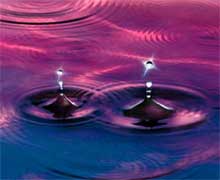

Website author: Amanda Burns © 2000
Web graphics
When creating images for the web you should be aware of several factors: format, colour, download speed and transparency.
Currently the most widely used image formats on the web today are GIF and JPEG. Generally speaking, the GIF format is used for images that maintain transparency, that is the background of the graphic maintains a transparent appearance allowing anything behind the image to appear.



The JPEG format is most useful for images that contain many gradients of colour such as photographs. JPEG is much better at compressing these types of graphics. The downside of JPEG is that it does not maintain transparency when saved.
The image to the right is 6k in jpeg format. To get the same result in gif it would be 19k.
Colours
When selecting colours for your images it is often prudent to select from the 216 web-safe colour palette. Most monitors can only display 256 colours and many browsers reserve up to 40 of those colours for their own use. Hence, the 216 colours you have left to play with.
This is useful where you have an image with a non-rectangular shape and a page background that contains a contrasting image or colour.
The two buttons to the left demonstrate how transparency is important when creating images on filled backgrounds. The top image is a gif. The bottom is the same image in jpeg format.